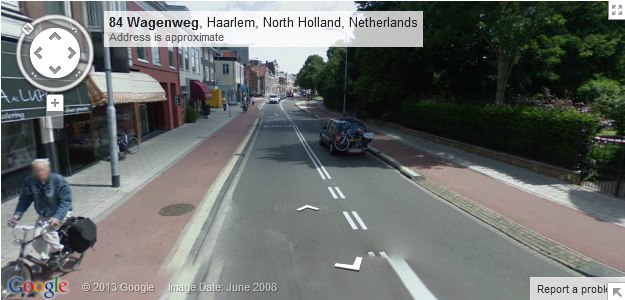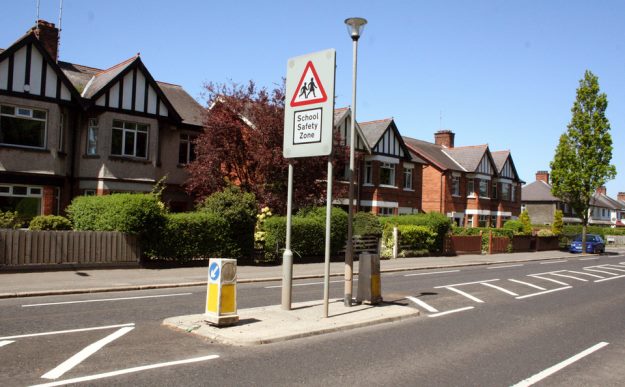You might think road regulations won’t allow for such a design in Northern Ireland; you may not be right.
The rat run at My Lady’s Road is a blog post in itself for another time, and London Road and Ravenhill Avenue don’t suffer from particularly heavy traffic flows – traditional calming methods could be easily deployed to discourage through-traffic.
Conall McDevitt’s 20mph Bill will be debated in the Assembly in the Autumn, and is understood not to be supported by the Department for Regional Development. Blanket 20mph limits on the residential streets here would be a great boost to active travel.
Ravenhill Park
To develop a high quality east-west cycling corridor with Ravenhill Road as the axis requires one major piece of road management. Linking the Connswater Greenway at Cregagh to the Ormeau Park and Lagan Towpath is possible by creating a traffic-calmed route along Ravenhill Park.
At the moment Ravenhill Park is one-way going west, which makes it a fast popular rat run route for traffic trying to reach the Ormeau Road from East Belfast. It’s also an unnecessary barrier to eastbound cycling journeys using the Park Road cycle lane – even (illegal) footpath cycling against the traffic isn’t possible due to high kerbs.
A simple, if radical, solution would be making Ravenhill Park and Onslow Parade 2-way again, but placing a barrier to vehicles beside Ravenhill Rugby Ground – removing all through traffic, calming speeds to solely residential users, and opening a new cycling corridor. Retractable bollards would be an ideal solution to allow fully flexible traffic management for Ulster Rugby matches and events at the new Ravenhill Rugby Ground. The Onslow side has a natural cul-de-sac turning circle at the stadium, and the nearby Ravenhill Park Gardens junction could provide a similar function on the park side.

Eastbound rat run traffic is unlikely to divert to Ardenlee Avenue, reverting to the more suitable Mount Merrion corridor. Westbound traffic wishing to use Park Road and Ardenlee as a cut-through from Ormeau to Cregagh can be discouraged by the lack of right turning boxes, changing the design of Ardenlee to a more residential style with raised entrances and cycle track priority, and further traffic calming.
Ormeau Park cycleways
Ormeau Park actually creates a minor barrier to the success of the future Gasworks Bridge. To be a truly transformative active transport corridor, new cycleways across the park, with lighting for the winter months, would be needed to for the most efficient journeys.
The lack of a bridge over the Lagan means there are no direct ‘desire line’ paths going east-west across the park. The ‘cage gate’ entrances designed to discourage cycling and prevent motorcycles accessing the park must be replaced with a better solution.
[youtube=http://www.youtube.com/watch?v=hZEum3RpJ8I&w=640&h=360]
Belfast City Council’s parks opening hours (7.30am in the morning until sunset, as early as 5pm in the winter) would also cut into a large portion of homeward ‘rush hour’ and the potential to drive citybound evening economy journeys. Diverting people around the park would make the corridor and cycling less attractive. Ormeau Park would need a new 6am to midnight year-round policy.
Re-imagine Belfast and demand better
The potential Gasworks Bridge opens a range of possibilities and the chance for new thinking on how to move people around Belfast. Our streets are dominated by vehicles, but this is as much down to road design as to personal preference. Ideas and discussion are important to changing mindsets and building the space for active travel. In a city with rising congestion, falling car ownership, troubling levels of obesity and a more dangerous environment for cycling, tacking little bits of advisory cycle lane onto intimidating roads is no longer an acceptable waste use of public money.
Northern Ireland must learn from and implement best practice from the Netherlands for how to develop the safest and most attractive cycling space. This is how London is approaching its cycling vision, and Belfast realistically has an opportunity to lead the United Kingdom in cycling uptake, given the natural advantages for cycling. Belfast Bike Hire, the Giro D’Italia, rising commuter levels, the Gasworks Bridge – the stars are aligning for something truly special to happen in our city.
Give the people safe space to cycle and they will choose to do so in droves. Continue to pretend that Belfast’s roads are fit to promote as an genuine active travel option and we will all lose.










